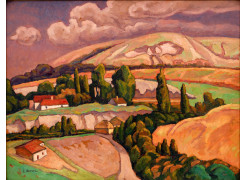Additional info:
Camil Ressu occupies a central place in the history of Romanian interwar art, with a body of work that established a personal idiom at the intersection of realist observation and classical monumentalism. His training began in Bucharest under Gheorghe Mirea and continued in Iași with Gheorghe Popovici, later enriched by formative experiences in Munich and Paris, where engagement with the Western art milieu consolidated his mastery of drawing and the structural rigour of form. From the early caricatures in the Bucharest press, where incisive draftsmanship articulated social critique, to his large-scale compositions devoted to rural life, Ressu’s trajectory demonstrates a consistent engagement with the social and cultural realities of his era. His style emerged through a synthesis of Cézanne’s structural principles - visible in his constructive organisation of form - and the French realist tradition, filtered through a Romanian sensibility. The Romanian peasant became the central figure of his oeuvre, not depicted idly or decoratively but endowed with a solemn, monumental presence, marked by archetypal traits and a sense of ethnic continuity. In works such as Harvesters Resting and Ploughing, man is inseparable from nature, integrated into a balanced and sober universe where stillness and permanence acquire visual significance. At the same time, Ressu excelled as a portraitist, capturing not only the physiognomy but also the inner structure of his sitter. Portraits of Nina Arbore, Mihail Sadoveanu or the collector K. H. Zambaccian demonstrate compositional rigour and a profound understanding of visual dialogue, highlighted by what German critics termed as Blickkontakt - the exchange of gazes that establishes communication between subject and viewer. His self-portraits, from the early example in a red coat to later works, confirm this constant reflection on artistic identity. Through his rural subject, Ressu directly engaged with debates on national specificity in art, while consciously rejecting populist aesthetics or the semănătorist legacy, which he explicitly opposed. His vision of Romanian authenticity was not founded on the idealisation of folklore but on careful observation of everyday life, translated into a realist-constructivist idiom. This critical stance places him alongside his contemporaries, yet with a consistency that secured his position as one of the most authoritative voices of Romanian modernism. Critical reception was favourable even during the interwar decades, when his oeuvre was recognised as a benchmark in defining a national canon. His academic career, beginning in 1925 and culminating in his tenure as rector of the Bucharest Academy of Fine Arts, reinforced his influence as a mentor to younger generations. Ressu remains an artist whose work not only reflects but also transforms the tensions between modernity and tradition into a coherent visual discourse, firmly situated at the crossroads of Romanian art history and the international circulation of pictorial ideas.
-
Ion Grigorescu
b. Bucharest, Romania, 1945 -
Ion Popescu Negreni
Negreni, Romania, 1907 - Bucharest, Romania, 2001 -
Sándor Ziffer
1880 - 1962 -
Alexandru Paul
b. 1971 -
Petre Velicu
b. Bucharest, Romania, 1950
